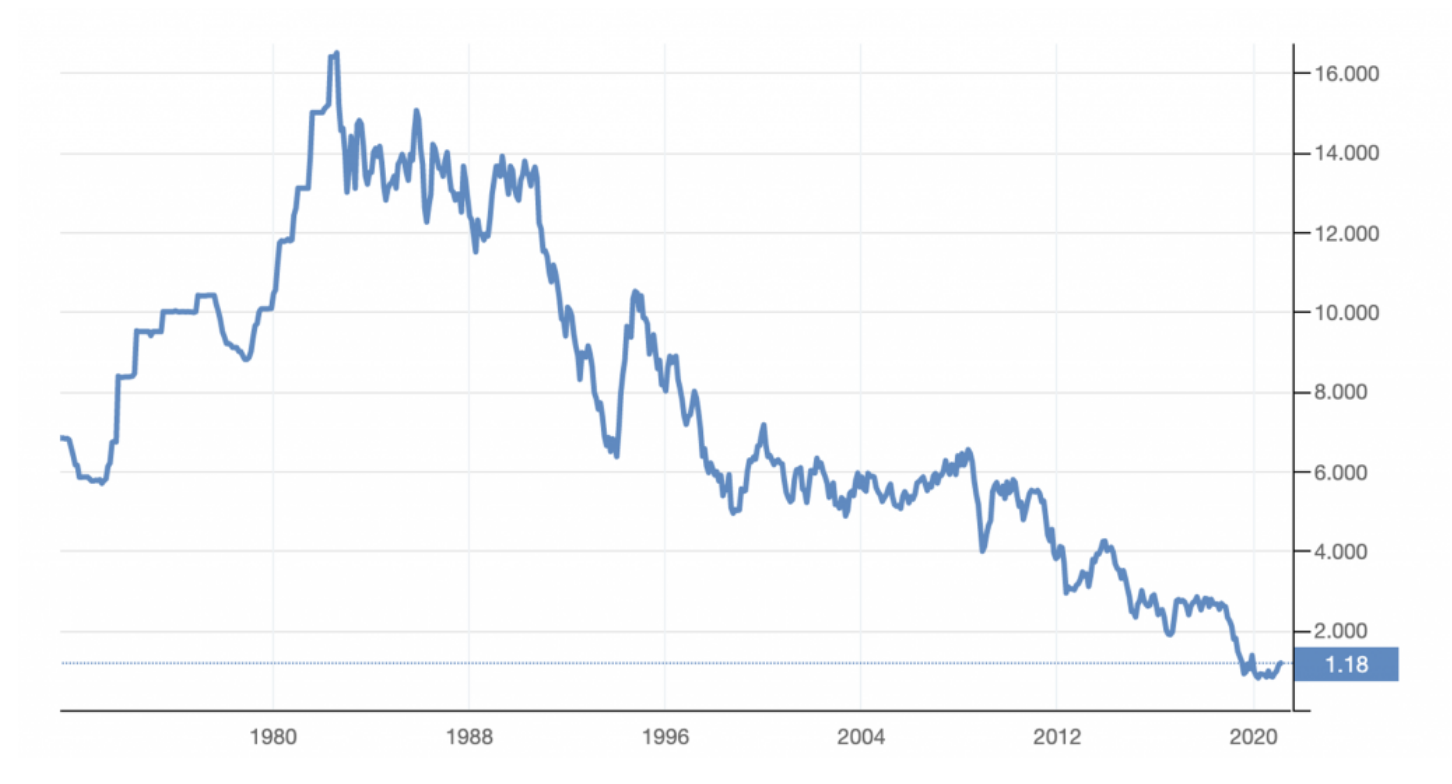Bubble, bubble toil and no trouble!
There are a number of arguments being advanced to suggest the stock market is in a gigantic bubble that is at risk of bursting imminently. Some of the arguments relate to broad overvaluation, the tidal wave of overpriced IPOs that double on listing, and the observation that interest rates remaining low forever is tantamount to the unrealistic, and previously unrealised, expectation of high rates of earnings growth being sustained forever.
For this article however I want to look at the market’s valuation compared to bond yields to help understand the extent of any euphoria in markets that may cause them to be at risk of imminent collapse.
Australian ten-year bonds have traded almost in lockstep with their global peers over recent decades, and since the early to mid 1980’s bond yields have been in inexorable decline.
Figure 1. Australian ten-year bond yields 1980-2020

Source: Tradingeconomics
According to Bloomberg, the ten-year Australian bond yield is 1.17 per cent. The bond yield will move independently of short-term cash rates set by the Reserve Bank of Australia, so while the RBA Governor Philip Lowe has made it clear that the overnight cash rate of 0.1 per cent will not be moving for some years or until inflation is “sustainably” in the target band of 2-3 per cent, that does not mean the yield curve cannot steepen with ten-year bond yields rising.
Nevertheless, the starting point for one method of assessing equity market valuation is the ten-year bond yield. To that yield we add an equity market risk premium. On this number there is much conjecture. The equity market risk premium is the average return that investors require over the risk-free rate (ten-year treasury bonds for example) for accepting the higher variability in returns that are typical of equity investments. In other words, the Equity Market Risk Premium reflects a minimum threshold that motivates investors to invest.
Investors and academics have long debated this number, which of course changes over time. Turning to the RBA again, and its June 2019 Finance Bulletin – The Australian Equity Market over the Past Century, reveals the following:
“Using the updated dividends data, the new historical series (extended with available data for more recent time periods) imply that the total nominal return on equities (i.e. the sum of capital gains and dividends) has been around 10 per cent, per year over the past 100 years (based on a geometric average which allows for compounding over time). In real terms – i.e. after accounting for inflation – the average annual return was about 6 per cent. There have not been material differences in returns across sectors over this time, although of course there have been periods in which sectors have performed differently. Over the same period, the total nominal return on long-term government bonds has been around 6 per cent, implying an average equity risk premium (excess return of equities over safe assets) of around 4 per cent.”
So, to the bond yield of 1.17 per cent, we should add four per cent for the equity market risk premium. The product of the two is of course 5.17 per cent. This is the theoretical fair value Earnings Yield for the market.
The Earnings Yield is of course merely the inverse of the Price Earnings ratio so, by dividing 100 by the earnings yield we can arrive at a theoretical fair PE for the market of 19.34 times earnings.
If the 1-year forward PE of the market is much higher than this, investors are willing to accept a narrower than reasonable future return above bonds, given the risk of investing in equities.
According to Bloomberg at 12.17 pm on 3 February 2021, the 1-year forward PE for the ASX200 (excluding loss making companies) is 19.26. By including loss making companies the 1-year forward PE is 20.55 times suggesting there is only marginal enthusiasm for equities overall.
This picture of course changes throughout each day. As bond yields rise, the fair value of the market falls, and the reverse occurs when bond yields decline. If bonds yields do begin marching materially higher the risk for the market rises, even if the market itself does not rise. This is because the fair value PE would decline moving further below current levels.
Today, as it stands however, on this measure at least, it doesn’t appear that the Australian stock market is in a bubble.
Not already a Livewire member?
Sign up today to get free access to investment ideas and strategies from Australia’s leading investors.
3 topics

